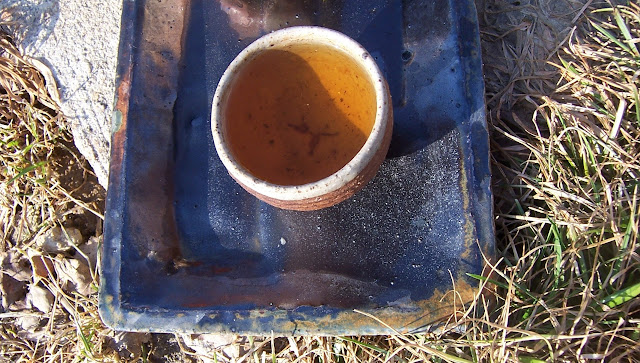You have probably heard about difficulties in tea gardens of Darjeeling this year. Gorkha – the ethnic group brought there by British more than hundred years ago – are blocking gardens. About whole situation there you can read on many places. In spite of this situation, most of tea merchants who are focused on teas from Darjeeling have already chosen which FF DJ they are going to offer to customers. Hundreds of samples have been sending all around the world. But those fresh LOTs are now still sitting in India- if my information is still “up to date” then only few LOTs arrived to France. Such pity for rest of tea lovers! Today I find some good news about it - here
Opening the small bag -the familiar and unmistakable fragrances hits my nose. It always reminds me smell of fresh but ripe poppy seeds. Behinde this expressive face there are flower and fresh, greeny hay...
For those fresh samples I decided to use also fresh teapot -just brought from the kiln. This rusty, sandy clay is still quite new for us and I was curious how it will works with freshness of Darjeeling tea. And I was happy about it...
..
If I should say one and first taste which showed to me it would be grapefruit -with its "juicy power" and sweet bitterness. After that I finded some meadow flowers and again green hay.... When you see this yellow, bright liquer you do not expect such strong taste as there is - if you are not heavy FF DJ drinker.
What was even more interesting for me was how thick the liquor in my mouth was. In my memories I always have spring Darjeeling tea as tea of aroma and taste but with watery mouth feel. The thickness of this tea was really enjoyable for me this time. I was wondering about it and also trying rest of those samples. Probably most significant here is water. During autumn we have moved to new place and water to our tap goes directly from hills. And good FF Darjeeling is sensitive guy...
It is always funny to examine leaves -here you can see several basic types...hairy buds, bright green, yellow green and few oxidized, brown ones. Most of those leaves were too small to be convincingly taken by my camera. So please take a look in to my teapot...
I wish to Gorkha people freedom and socioreligious peace. And to tea lovers patience -it is comming. It is worth to wait...
As my dear friends (and also my customers) run the tea-eshop Darjeeling.cz I got wonderful gift –four samples from four different tea gardens. Daniel told me that they had to test almost thirty samples and make decision very quickly – Which spring leaves will be the best for their customers this year ? It can be both nice and tricky job!
I was not in Darjeeling mood for a very long time. Enjoying world of Puers and oolongs I was far to be impatiently looking for first sip of fresh First Flesh. But I had to admit, those fresh aromas and sharp tastes hit me. The tea I am going to show here is from Marybonc garden.
Opening the small bag -the familiar and unmistakable fragrances hits my nose. It always reminds me smell of fresh but ripe poppy seeds. Behinde this expressive face there are flower and fresh, greeny hay...
For those fresh samples I decided to use also fresh teapot -just brought from the kiln. This rusty, sandy clay is still quite new for us and I was curious how it will works with freshness of Darjeeling tea. And I was happy about it...
..
If I should say one and first taste which showed to me it would be grapefruit -with its "juicy power" and sweet bitterness. After that I finded some meadow flowers and again green hay.... When you see this yellow, bright liquer you do not expect such strong taste as there is - if you are not heavy FF DJ drinker.
| The green plate is Mirka's work -it fits to my spring mood very well... |
It is always funny to examine leaves -here you can see several basic types...hairy buds, bright green, yellow green and few oxidized, brown ones. Most of those leaves were too small to be convincingly taken by my camera. So please take a look in to my teapot...
I wish to Gorkha people freedom and socioreligious peace. And to tea lovers patience -it is comming. It is worth to wait...



